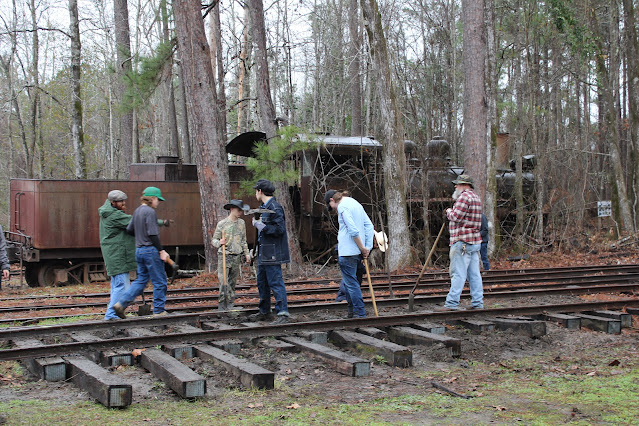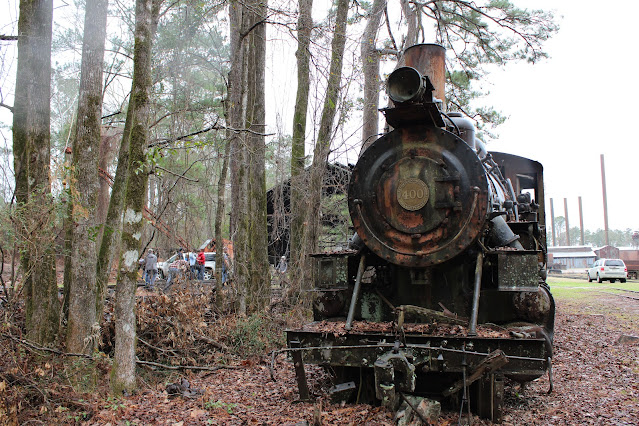Why would a group of men and women brave pouring rain and winter cold to spend their Saturday working on a railroad that hasn't run since 1954?
The Read River & Gulf Railroad ran it's last train from Lecompte to the saw mill complex at Long Leaf. Louisiana on March 30, 1954. The railroad that had once operated over some seventy miles of track had become too expensive to operate and maintain. The money it generated suppling lumber to the Long Leaf Mill could no longer pay the bills.
All the railroad's equipment, including several steam locomotives, numerous pieces of rolling stock, various structures and several miles of track, were simply abandoned and allowed to deteriorate for decades.
Likewise the Long Leaf Mill closed it's doors in 1969 after seventy-six years of operation and it, plus the adjacent town, also were abandoned.
Let's flash forward to 2023 and the remains of the railroad, the saw mill complex and the town of Long Leaf are all under the stewardship of the Southern Forrest Heritage Museum. Due to the hard work of intrepid volunteers the once left for dead mill complex has been cleared of all the flora and debris that overran the property during decades of neglect.
On this past Saturday a group of twenty-two such intrepid volunteers gathered in the cold and wet early hours to begin working on the remains of the Red River & Gulf Railroad. A railroad that had ceased operation long before any of them were born. Their goal for the day was to begin laying the groundwork for a new switch and a new section of track that will allow them to move old railcars indoors for reconstruction and renovation.
 |
| RR&G Superintendent Everett Lueck explains the railroad's future plans to new volunteers. |
Today the volunteers were under the direction of the museum's General Railroad Superintendent Everett Lueck, a man whom these volunteers affectionately refer to as 'a walking encyclopedia of Long Leaf Mill history'. Lueck has been a part of the museum's history and vision for thirty years and he believes that the resurrection of the once dead Red River & Gulf Railroad is now becoming a reality.
Lueck explained to a small group of new volunteers, "It is our goal to have a working railroad here within the next five years."
His optimism is fueled by the recent addition of a vintage Heisler steam locomotive that is owned by one of the volunteers and is presently being rebuilt in one of the old Red River & Gulf machine shops and the discovery of many of the old railroad's rolling stock in the nearby woods. What's left of those old railcars are to become brand new cars to carry tourists pulled by the Heisler. Lueck also noted that there are two more locomotives, the former RR&G 4-6-0 number 106 that has been going under intense cosmetic restoration and the former Meridian Lumber Company 4-6-0 number 202 which is stored inside the machine shop, that with time and money could be restored to working order.
Lueck stated that '..the insides of number 106 are in better shape than most of the steam locomotives in operation today."
The main reason that Lueck speaks of a fully operational new RR&G built from the remains of it's ancestor in matter of fact terms instead of just an optimistic possibility is the passion and dedication demonstrated by these volunteers who give up their free time for one or two weekends a month to do all the hard labor it takes to build a functioning railroad.
Each one of these volunteers share in the dream that they are diligently working towards making a reality. They all share in a love for railroads and history, it is passion to them. This passion runs so deep that many of them travel several hours just to come to work and even bitter cold and pouring rain isn't enough to deter a single one of them from getting the job done.
On this rainy and cold Saturday morning this group of men and women armed with the very tools and techniques that workers on the Red River & Gulf used decades ago began laying groundwork on that new switch. The process was slow, tedious and back-breaking. A team of workers armed with shovels and picks went to work digging out trenches for new ties under the existing tracks while another moved those ties into place. The group armed with shovels would then come in and fill in the displaced earth around the ties securing them in place. It was quite a site to see the whole operation in action and it was very inspiring to see the group seemingly unfazed by periods of pouring rain. While the rain fell the group kept on task as if they failed to notice it.
They work only stopped when it was time for a well deserved break for lunch.
From what I witnessed this day I have no doubt that the Red River & Gulf will truly live again. The love and dedication on display for this historic old logging railroad is more than inspirational. It's a passion that's being passed down from the elder members of the group into the hearts of the younger generation in attendance. It was also heartwarming to see several children on site as well. Undoubtedly growing up around something special like this will inspire family traditions that will keep the RR&G alive far beyond the generations who are presently working tirelessly to bring it back to life.
It should be noted that that all of this is only possible because of the hard work of volunteers and the funding provided by private and public donations.
If you would like to join the team and volunteer your time to help make all of this happen you can send an email to Work-Sessions@RedRiverAndGulf.net
If you would like to make a donation to the Southern Forest Heritage Museum please visit - https://southern-forest-heritage-museum.square.site/donate
Memberships are also available at - https://southern-forest-heritage-museum.square.site/membership
Here is a map to the Southern Forest Heritage Museum:
Here are some more photos from Saturday's work session:
 |
| Locomotive #202 and the newly acquired Heisler under restoration in the old RR&G workshop. |
Check Out:






















No comments:
Post a Comment